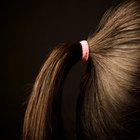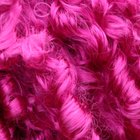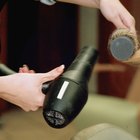Composition of Synthetic Hair
Synthetic hair fibers are fine threads manufactured to resemble human hair. Manufacturers may use single type, monofilament fibers, or a combination of two or three, polyfilament, fibers, Acrylic or polyester is used to make some fibers. Wigs and hair extensions, which are constructed of synthetic hair, are more affordable than similar items made from human hair. An extensive search revealed three U.S. patents which addressed the process of manufacturing synthetic hair for wigs, the process of manufacturing locks of hair from synthetic fibers, joining synthetic hair, and a method of producing wear resistant synthetic hair.
Producing a Heat Resistant and Wear Resistant Product
The idea of U.S. Patent 4813969 is to manufacture synthetic hair that has a high thermal resistance. Each hair fiber is given a diffuse light refraction by altering its structure surface. This is done by chemically disturbing the surface. The surface of a single filament polyester fiber is disturbed by means of a corrosive alkaline lye. The solution of about 20 grams/liter of natrium hydroxide is applied to the fiber at a temperature of 96 degrees to 100 degrees Celsius.
The proposal of U.S. Patent 6343606 is to create a wear resistant synthetic hair product. This is achieved by mixing a monofilament nylon 6 mat with a diameter of approximately 0.09 millimeters. The fiber is 0.55 percent titanium dioxide and 0.37 percent calcium carbide by weight. The composition is heated to a temperature of 150 degrees Celsius.
The idea of U.S. Patent 4377427 is how to join the synthetic fibers into locks of artificial hair. The locks of synthetic hair are grouped into bundles, welded together and cut by ultrasonic waves. Each fiber bundle is placed on a platform which has a pointed ridge. A component which is comprised of the emitter and an ultrasound tool is moved downwardly in two stages. The emitter is deactivated and returned to its upper position.
U.S. Patent 3727619 is a method for joining synthetic hair and human hair. Ultrasonic vibrational energy is used to join synthetic and human hair together. Overlapping portions of synthetic hair and human hair are maintained in a fixed position to each other. Energy is introduced. The hair may be coated with a thermoplastic material which acts as the bonding agent.
Related Articles

Types of Cotton Fabric

Chi Silk Infusion Ingredients

What Is Synthetic Hair Made Of?

Synthetic Hair Vs. Kanekalon Hair

How to Re-Curl a Synthetic Wig

Removing Hair Extensions With Acetone

How to Make Headband Wigs

What Is the Difference Between Cutting ...

What Is a Capless Wig?

Getting Hair Glue Out With Rubbing ...

Who Invented Hair Weaves?

What Is Clear Matrix Color Sync?

How to Apply Wave Nouveau

How to Put in a Drawstring Ponytail

How Were Colonial Wigs Made?

How to Add More Curl to My Wavy Hair

How to Do a Sew-In Hair Weave on a ...

How to Make a Straight Wig Curly

What Is a Rat Hair Piece?

Steps for the Straw Set Method of ...
References
Writer Bio
Maryann Gromisch is a registered nurse and a freelance writer. She has clinical experience in medical, surgical and critical care nursing. Since October 2009 she has written articles related to the digestive system for Empowher.com, a women's health online magazine. She has a bachelor's degree in nursing from Southern Connecticut State University, New Haven.